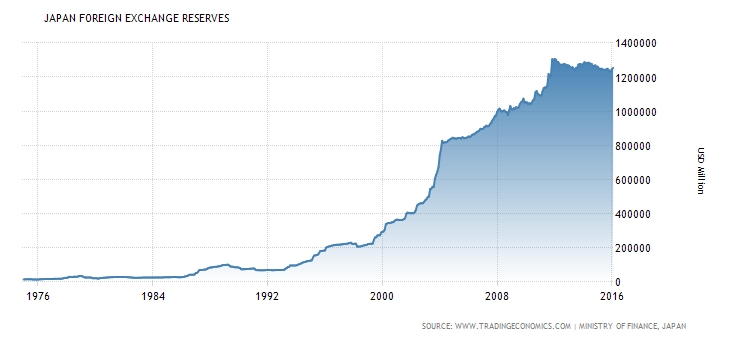During all of this, Japan had been accumulating foreign exchange (dollars – see Figure 13).

The accumulation of foreign exchange reserves far beyond a level considered adequate to deal with emergency situations, requires some explanation, for it is a major part of the export-first strategy of the Asian Tiger model.
There are other tools for maintaining a competitive advantage in currency exchange rates, but the major one involves foreign exchange holdings, and we have already encountered it. It goes by the name of sterilization.
The sterilization model looks like Figure 14.

What happens here is similar to the gold sterilization model depicted in Figure 8. Japan is running a trade surplus with the USA which it wishes to maintain, so as to keep its export production apparatus functioning prosperously. Normally, the dollar proceeds from its export sales would be repatriated to the producers, who would remunerate factors of production – that money would then pay for consumption and domestic demand would rise. But this would not be good for the export industry. Not only would resources be shifted to production for the domestic market, but the increased monetary circulation and productive activity would lead to an appreciation of the exchange rate, pricing Japanese exporters out of their markets. So instead of allowing dollars to be repatriated into yen, a significant portion is shunted off to the Bank of Japan (actually an institution under the BOJ’s control, known as the Foreign Exchange Special Account). This keeps it separate from the Japanese real economy. Instead, it goes into the financial markets, mainly in the purchase of US Treasury bills.
Japan’s dollar holdings held steady at $20-30 billion until after 1986, and this money helped fund the deficit spending engaged in by the USA during the Reagan years. But then those holdings ballooned. What happened? Firstly, the dollar’s exchange rate plunged. This went far beyond what was desirable, prompting Japan’s monetary authorities to undermine the yen and bolster the dollar through additional sterilization. This process then took off, as can be seen in Figure 15.

This shows “the rest of the story,” i.e., what happened as the sterilization process continued unabated. As figure 14 shows, the level of dollar sterilization reached mammoth proportions, first in the 1990s and then especially after 2000. The buildup was accompanied by ongoing trade surpluses until around 2011, because the two are correlates of each other (see Figure 16).

The effects this had on the world economy will be discussed later. For now, what needs to be understood is that this sterilization effort proved to be an end of the road for the Asian Tiger model as carried out in Japan. The export model which was so successful in the 1970s and 1980s crashed in the 1990s, and no amount of currency sterilization and yen undercutting could maintain the level of prosperity. This is because the export model deliberately undermines domestic productivity and consumption, forcing the Japanese work force to “save,” i.e., forego consumption as their earnings are shunted off in other directions than their own pockets.
